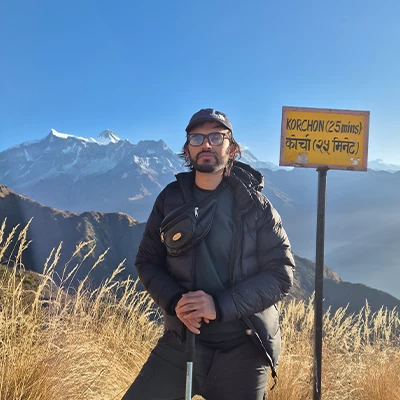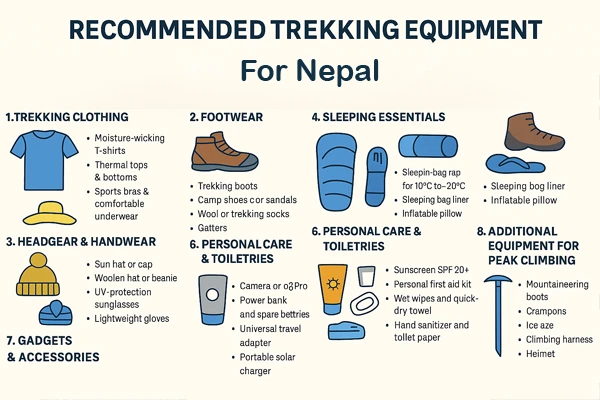Annapurna Base Camp Trek Overview for Beginners
The Annapurna Base Camp Trek is a classic Himalayan route that takes trekkers deep into the heart of the Annapurna region. Starting typically from Pokhara, the journey winds through terraced farmlands, rhododendron forests, and traditional Gurung and Magar villages. You will gradually ascend to the high alpine landscape of the Annapurna Sanctuary. The trek usually takes 7 to 12 days, depending on the chosen itinerary and pace, covering an average of 8–12 kilometers per day. The highest point is Annapurna Base Camp at 4,130 meters (13,549 ft), which is significantly lower than the Everest Base Camp’s 5,364 meters, making altitude easier to manage for beginners. Along the way, trekkers enjoy panoramic views of some of the world’s most iconic peaks, including Annapurna I (8,091 m), Machapuchare (6,993 m), Hiunchuli (6,441 m), and Gangapurna (7,455 m). One of the main highlights is reaching the natural amphitheater of the Annapurna Sanctuary, where towering mountains surround you on all sides in a breathtaking 360° panorama.
For beginners, ABC is often considered a balanced trek. It has physical challenges such as steep stone staircases and long walking days, yet it also offers accessible accommodation in teahouses, frequent meal stops, and well-marked trails. The combination of cultural encounters, diverse landscapes, and achievable altitude makes it one of the best introductory treks in Nepal. This trek is best for those who want their first Himalayan adventure to be both challenging and rewarding.
Annapurna Base Camp Trek Difficulty Level Explained
The Annapurna Base Camp Trek is often labeled as “moderate,” but it can feel demanding at times for beginners. The trek does not require technical climbing skills, ropes, or crampons, but the physical challenge lies in the daily walking hours, steep stone staircases, and altitude gain. On average, you will walk 5–7 hours a day, covering anywhere from 8 to 15 kilometers. Some days feel easier with gentle ascents through farmlands and forests, while others test endurance with endless stone steps and uphill climbs.
Trail conditions: stairs, steep climbs, and descents
One of the most difficult aspects for beginners is the relentless stairs. Villages like Jhinu Danda, Chhomrong, and Sinuwa are famous for their steep staircases that go down for hundreds of meters only to climb back up again. These ups and downs can be tough on the legs, especially the knees. For many, the challenge is not a single steep climb, but the repetition of these ascents and descents throughout the trek.
Comparing ABC Trek difficulty with Everest Base Camp
The altitude is another factor, though it is generally less intense compared to other high Himalayan treks. Annapurna Base Camp sits at 4,130 meters (13,549 ft), where the oxygen level is about 60% of sea level. Most trekkers feel mild shortness of breath or fatigue as they approach base camp. But the risk of severe altitude sickness is lower than on treks like Everest Base Camp or Manaslu Circuit. Still, beginners must acclimatize properly by walking at a steady pace, staying hydrated, and allowing the body time to adjust.
In short, the Annapurna Base Camp Trek is challenging but achievable for beginners who are reasonably fit, walk at a steady pace, and prepare themselves mentally. The difficulty lies not in technical danger but in stamina, persistence, and managing altitude. The reward, however, is unparalleled: standing at base camp surrounded by towering Himalayan peaks makes every step worthwhile.
Altitude on the Annapurna Base Camp Trek
One of the most important questions beginners ask is about altitude: “How is the condition of Annapurna Base Camp altitude?” The Annapurna Base Camp Trek is considered a moderate-altitude trek, but altitude is still a factor that cannot be ignored. The journey begins from 1,1780 meters (Jhinu Danda) and gradually climbs through villages like Ghandruk, Chhomrong, and Deurali before reaching the highest point at Annapurna Base Camp (4,130 meters / 13,549 ft).
The ABC route has a more gradual ascent and less overall time at extreme heights. This significantly lowers the risk of severe altitude sickness, making it more approachable for beginners. Still, altitude symptoms can appear after 3,500 meters. You should watch out for warning signs such as headache, nausea, fatigue, loss of appetite, or disturbed sleep. These are mild forms of Acute Mountain Sickness (AMS) and must not be ignored.
How beginners can prevent altitude sickness
To reduce risks, you should pace responsibly, walk slowly, and allow time for rest at key villages. Hydration is crucial, and drinking 3–4 liters of water per day helps the body adapt to thinner air. Avoiding alcohol and heavy smoking also plays a big role in acclimatization. Unlike technical climbs, the ABC Trek doesn’t require oxygen cylinders or advanced gear, but understanding your body’s limits is key.
The trek’s design itself supports acclimatization. The steady gain in altitude gives your body more time to adjust compared to treks that ascend rapidly. Spending a night at Machapuchare Base Camp (3,700 m) before pushing to Annapurna Base Camp offers a natural acclimatization step. This overnight stay is what makes reaching 4,130 meters both achievable and safe.
In essence, the altitude on the Annapurna Base Camp Trek is challenging but manageable. Beginners should approach it with awareness, not fear. With sensible pacing and proper hydration, most first-time trekkers successfully stand at Annapurna Base Camp, surrounded by towering peaks, without serious altitude issues. For many, this first taste of trekking at high elevation becomes a life-changing introduction to the Himalayas.
Fitness Requirements for Beginners
One of the biggest questions beginners ask is, “Do I need to be super fit to do the Annapurna Base Camp Trek?” The answer is No!, You don’t need to be an athlete or have trekking experience, but you do need a reasonable level of fitness, stamina, and determination. The ABC Trek involves 5–7 hours of walking each day, often on stone staircases that seem endless. Steep ascents through forests and long descents might test your knees. It is not a technical trek, and no ropes or climbing equipment are required, but it demands consistent effort day after day.
If you can walk comfortably for several hours on hilly or uneven terrain at home, you are already on the right track. Still, beginners are strongly encouraged to prepare their bodies in advance.
Easy training tips for beginners before trekking in Nepal
A basic training plan can make the difference between struggling and enjoying the journey. This does not need to be complicated:
Walking practice: Start by walking 8–10 km daily, ideally on inclines or trails. Gradually increase distance and elevation gain.
Strength training: Focus on legs (squats, lunges, step-ups), core (planks, crunches), and light upper-body exercises to help carry your backpack.
Cardio workouts: such as jogging, cycling, or swimming, three times a week, can improve endurance for long trekking days.
Hiking with a pack: Carry a loaded backpack during training walks to simulate real trail conditions.
Mental preparation for long walking days
Equally important is mental preparation. Beginners often underestimate how much persistence trekking requires. There will be moments of fatigue, when the stairs feel endless or the altitude makes each step heavier. Knowing that discomfort is part of the process and having the patience to move slowly but steadily can help you overcome those mental roadblocks.
A good reminder is that people of all ages, from teenagers to retirees in their 60s and 70s, have completed the Annapurna Base Camp Trek. Fitness is relative; what matters most is consistency in training, a positive mindset, and the willingness to push through challenges. For beginners, preparation doesn’t just make the trek easier; it transforms the journey into an enjoyable adventure rather than a painful endurance test.
Best Time to Do the Annapurna Base Camp Trek for Beginners
Choosing the right season is one of the most important decisions for anyone attempting the Annapurna Base Camp Trek. The Himalayas are known for their dramatic shifts in weather, and the experience of the trek can be completely different depending on when you go. The best time to trek to Annapurna Base Camp is during spring (March to May) and autumn (September to November). These two seasons offer stable weather, clear skies, and moderate temperatures.
Spring vs. Autumn trekking season
In spring, the trail comes alive with blooming rhododendrons, Nepal’s national flower. The flowers paint the hillsides in vibrant shades of red, pink, and white. Temperatures are pleasant, ranging from warm days in the lower valleys to cool but bearable nights at higher altitudes. For beginners, this season feels welcoming with less risk of snowfall compared to winter and fewer muddy trails than during the monsoon. The air is crisp, and mornings often reveal crystal-clear views of Annapurna, Machapuchare, and Hiunchuli, making the effort of early starts deeply rewarding.
Autumn is equally popular for the Annapurna Base Camp Trek. After the heavy summer monsoon rains, the skies clear up, and the atmosphere is freshly washed. This gives you some of the sharpest mountain vistas possible. Rice fields turn golden, villages buzz with the energy of harvest, and festivals like Dashain and Tihar bring cultural vibrancy to the journey. Daytime temperatures are moderate, and nights at high altitudes, while cold, are manageable with the right clothing. Autumn provides a stable and predictable trekking environment, minimizing surprises like sudden storms or trail blockages.
Why avoid monsoon and winter as a first-timer
On the other hand, monsoon (June to August) and winter (December to February) are not recommended for beginners. During the monsoon, trails become slippery and leech-infested, landslides are more common, and clouds often obscure the mountains. While the valleys look lush and green, visibility is poor, and daily rain can test the patience of new trekkers. Winter brings fewer crowds and dramatic snowy landscapes, but temperatures can plunge well below freezing, teahouses may close, and icy trails make walking risky. Such conditions demand higher preparation and resilience, which can be overwhelming for first-time trekkers.
For beginners who want the best balance of safety, scenery, and comfort, spring and autumn are ideal. These seasons not only reduce the physical strain caused by extreme weather but also maximize the joy of trekking through diverse landscapes. Walking beneath rhododendron canopies in spring or across freshly harvested terraces in autumn, with the towering Annapurnas glowing in the background
Accommodation and Food on the Annapurna Base Camp Trek
Step into a teahouse at dusk. Boots line the porch. A cast-iron stove hums in the center of a wood-paneled dining room. The owner slides a pot of ginger tea across the table. This is the rhythm of ABC: simple rooms, warm common spaces, hot meals made to order, and mountain views for dessert.
Teahouse basics
Rooms: Twin beds with foam mattresses, a pillow, and a quilt/blanket. Walls are thin. Bring a warm sleeping bag and earplugs. Windows often frost at higher elevations.
Bathrooms: Mix of western and squat toilets. Lower villages may have attached bathrooms; higher up, expect shared facilities. Toilet paper is not guaranteed. Carry your own.
Showers: Solar or gas-heated when available. Hot water can run out by late afternoon. You have to pay per shower of around USD 5.
Heating: Dining rooms are heated in the evening by a stove. Bedrooms are unheated. Layer up after sunset.
Power & charging: Electricity is reliable in lower villages, metered higher up. Charging is paid per device or per hour. Bring a power bank.
Connectivity: NTC/Ncell signals are decent in the lower sections and patchy in the sanctuary. Some lodges sell paid Wi-Fi vouchers. Do not rely on them.
Water and hygiene
Drinking water: Boiled water available for a fee. Many trekkers use purification tablets or a filter bottle.
Hand hygiene: Soap may be limited. Carry sanitizer. Wash your hands before every meal to reduce stomach issues.
Sustainability: Refill bottles instead of buying plastic. Pack out small trash and batteries.
How meals work
Menus are near-standard across the route. Kitchens cook to order, which takes time at altitude. Place dinner and breakfast orders right after you arrive in the teahouse.
Breakfast staples
Porridge or muesli with milk or honey
Tibetan bread or chapati with jam/peanut butter
Pancakes or omelets
Tea, coffee, hot lemon, ginger honey, lemon
Lunch and dinner mainstays
Dal Bhat (rice, lentil soup, vegetable curry, pickles). Free refills are common. Most reliable fuel.
Thukpa (noodle soup), mo:mo, fried rice/noodles with veg/egg/chicken (where available).
Curries with rice, sizzlers, simple pasta or potato dishes in mid-elevations.
Soups (garlic, tomato, veg) for cold evenings.
Snacks and hot drinks
Roasted potatoes, popcorn, biscuits, Snickers/energy bars.
Caffeine: Coffee varies in quality. Tea is consistent and hydrating.
Dietary needs
Vegetarian: Easy throughout; dal bhat and veg curries are dependable.
Vegan: Feasible with clear requests (no ghee, no egg, no milk).
Gluten-light: Rice-based meals help. Communicate needs simply and early.
Allergies: State them when you check in and again when ordering.
Prices and payment reality
Costs rise with altitude and remoteness. Expect separate charges for hot showers, Wi-Fi, and device charging. Carry enough cash from Pokhara; there are no ATMs on the high trail.
A day in food: sample plan
Breakfast: Tibetan bread, omelet, hot lemon.
Lunch: Dal bhat veg, refill once, ginger tea.
Tea stop: Biscuits and black tea.
Dinner: Garlic soup, veg fried rice, chamomile before bed.
Comfort tactics for beginners
Order early. Kitchen queues grow after groups arrive.
Eat for altitude. Prioritize warm soups, carbs, and dal bhat over heavy fried food near ABC.
Hydrate on a schedule. 3–4 liters per day, mixed plain and hot drinks.
Protect your stomach. Peel fruit, avoid raw salads at higher lodges, use purified water even for brushing.
Sleep warm. Sleeping bag + lodge blanket, dry base layer, warm hat.
Essential Packing List for Beginners on the ABC Trek
Packing for the Annapurna Base Camp Trek is often where beginners feel most overwhelmed. The truth is, what you carry can either make the journey enjoyable or unnecessarily exhausting. Trekking in the Himalayas demands gear that keeps you warm, dry, and comfortable while also being light enough to carry over long hours of walking. Beginners often make the mistake of overpacking, but the key is to focus on essentials and remember that less weight equals more energy on the trail.
Must-have trekking gear and clothing
Packing the layered clothing is a very important thing to consider while packing clothes. Temperatures can vary dramatically from warm, sunny days in lower villages to near-freezing nights at higher altitudes. You should think in layers: a moisture-wicking base layer to keep sweat away, an insulating fleece or down jacket for warmth, and a waterproof shell to protect against wind and sudden rain. Trekking pants, lightweight T-shirts, thermal underwear, and a warm hat and gloves are must-haves. Since much of the ABC trail involves climbing thousands of stone steps, good-quality trekking shoes with ankle support are non-negotiable. Beginners who are not used to hiking should break in their shoes beforehand to avoid painful blisters.
Equally important are small but vital accessories. A headlamp with extra batteries, water purification tablets or a reusable water filter, trekking poles, and a quick-dry towel all make the trek smoother. Sunglasses and sunscreen protect against the strong mountain sun, while lip balm and moisturizer help with dry air at higher elevations. Many beginners underestimate the need for a comfortable backpack with proper straps, but this single item can decide how enjoyable your trek feels each day.
When it comes to sleeping, teahouses along the ABC trek provide beds and blankets, but temperatures at night can drop significantly. A three-season sleeping bag rated to at least –10°C gives beginners peace of mind and better sleep. On the food side, carrying a few energy bars, nuts, or instant coffee can be a morale booster when you need quick energy between meals.
Renting vs. buying equipment in Kathmandu or Pokhara
Another practical choice is deciding whether to rent or buy gear. Pokhara and Kathmandu have plenty of shops where beginners can rent sleeping bags, jackets, and trekking poles at affordable rates. This is ideal if you don’t plan on trekking frequently in the future. However, investing in a few personal essentials like shoes, a backpack, and base layers is worth it for comfort and hygiene.
Packing light as a first-time trekker
Finally, keep your load manageable. A backpack weighing no more than 8–10 kg is ideal for beginners carrying their own gear. If you hire a porter, you can bring up to 15 kg, but always pack smart. Essentials like passports, permits, cash in Nepali rupees, and basic first aid supplies should be packed in a waterproof pouch.
Packing for the Annapurna Base Camp Trek is about striking the right balance between comfort, necessity, and weight. Beginners who prepare thoughtfully often find the trek more enjoyable, with fewer worries about the weather or trail conditions. The right gear won’t make the trail easier, but it will make you stronger, safer, and far more confident as you take each step closer to the base of the mighty Annapurna.
Costs of Annapurna Base Camp Trek for Beginners
One of the biggest questions all asks before committing to the Annapurna Base Camp Trek is, “How much will the ABC trek cost?” The answer depends on how you choose to travel: budget style, mid-range comfort, or with a fully guided package. Unlike luxury trips, trekking in Nepal is flexible and can be adapted to almost any budget, which makes ABC an excellent choice for first-timers.
Permit fees, accommodation, food, and guide/porter costs
Talking about the permit fees, you only need an ACAP permit to do this trek. So, you need to pay USD 30 per person per visit. The SAARC countries have to pay USD 10 for the ACAP.
Accommodation is straightforward. You will stay in teahouses along the trail in basic mountain lodges run by local families. Prices range from USD 5–6 per night for a simple twin room, though many places will reduce or even waive the room charge if you commit to eating meals there.
Food is usually the largest daily expense. A plate of dal bhat (rice, lentil soup, and vegetables) costs about USD 5–8, while a simple noodle soup or fried rice is slightly cheaper. As you climb higher, prices increase due to the difficulty of transporting goods. In the lower villages, a meal may cost USD 5, but the same meal could be USD 8-9 at Annapurna Base Camp itself. On average, you should budget USD 40 per day for three meals and drinks, more if you want extras like coffee, chocolate, or hot showers.
Guides and porters are optional but highly recommended for beginners. A licensed guide costs USD 25–35 per day, while a porter (to carry up to 20–25 kg) charges about USD 18–20 per day. Hiring both adds to your budget but provides peace of mind, cultural insight, and physical relief.
Transport costs vary depending on where you start. A bus from Pokhara to Nayapul costs just a couple of dollars, while a private jeep is around USD 60, which you can split if trekking in a group.
Altogether, a budget trek without a guide/porter can be done for around USD 450–500 per person for 7–10 days, including permits, food, accommodation, and local transport. A guided trek with porter support usually costs USD 600–650, depending on how much comfort and assistance you want.
Whether you are a backpacker on a shoestring budget or a first-timer who prefers some comfort and guidance, the Annapurna Base Camp Trek is financially accessible. For many beginners, it becomes their first taste of trekking in the Himalayas precisely because it offers such a flexible price range without compromising on the mountain experience.
Safety Tips for Beginners on the Annapurna Base Camp Trek
Safety is one of the biggest concerns for beginners considering the Annapurna Base Camp Trek. The Himalayas are wild, unpredictable, and far from modern conveniences. But with awareness and preparation, the trek is absolutely manageable for first-timers.
Dealing with altitude sickness and emergencies
One of the main risks is altitude sickness because ABC sits at an altitude of 4,130 meters. While this is not extreme compared to higher treks like Everest Base Camp, the rapid gain in elevation can still affect beginners. The best way to stay safe is to trek slowly, take acclimatization breaks when needed, and listen to your body. Symptoms like headache, nausea, or dizziness should never be ignored; descending even a few hundred meters usually helps. Beginners should also stay hydrated (3-4 liters of water daily) and avoid alcohol at high altitudes.
Is it safe to trek ABC without a guide?
Another important safety factor is whether to trek with or without a guide. Solo trekking is allowed in the Annapurna region, and the trails are well-marked. But beginners often underestimate how confusing side trails or sudden weather changes can be. A guide not only ensures you stay on the right path but also provides local knowledge, cultural insight, and immediate support in emergencies. Hiring a porter can also reduce strain by carrying your heavy bag, which lowers the risk of injury or exhaustion.
Weather unpredictability is another challenge during the trek. Even in the best seasons (spring and autumn), sudden rain, snow, or landslides can occur. You hould carry proper gear: a waterproof jacket, sturdy trekking shoes, layered clothing for temperature changes, and a headlamp in case trekking extends into dusk.
Insurance and rescue options in the Annapurna region
It is also wise to consider travel insurance that covers high-altitude trekking and helicopter evacuation. While emergencies are rare, evacuation costs in Nepal can be thousands of dollars if you are uninsured.
Finally, be aware that while teahouses are comfortable, medical facilities on the trail are basic. Minor issues like blisters or stomach upset are common, so carrying a personal first-aid kit with essentials (bandages, rehydration salts, basic antibiotics, altitude medication if prescribed) is key.
Success Stories: Beginners Who Completed the ABC Trek
One of the most inspiring aspects of the Annapurna Base Camp Trek is the sheer number of beginners who arrive in Nepal with Hiking Adventure Treks. Most of them had little to no trekking experience and still completed the journey successfully. Their stories are a reminder that while ABC is physically demanding, it is also deeply achievable with determination and the right mindset.
Inspiring experiences of first-time trekkers in Nepal
At Hiking Adventure Trek, we have the profound privilege of witnessing everyday people achieve extraordinary things. The Annapurna Base Camp trek is a favorite for first-time adventurers, and their stories of transformation are why we do what we do.
The Anxious Student Who Found Her Strength
We remember a young college student who joined us, their excitement tinged with nerves. Their hiking experience was limited to city walks, and her backpack was filled with gear we helped her rent and pack. The initial climb to Ulleri was a challenge she met with determined breaths and the steady encouragement of our guide. We watched their stamina blossom each day, fueled by tailored pacing and reassuring advice. The moment she stood beside her guide at Annapurna Base Camp, tears welling in her eyes as the amphitheater of the Himalayas surrounded her, was a moment of pure success.
The Family That Bonded on the Trail
Trekking with teenagers or children is a beautiful challenge we expertly facilitate. For families choosing ABC, we provide expert guides who are fantastic with kids and plan flexible itineraries with extra rest stops. We see children’s natural curiosity come alive, pointing at yaks, playing card games with our staff.
This innate enthusiasm is infectious, giving parents a renewed sense of wonder that makes the physical effort feel lighter. It is not just a trek; it is an unforgettable family adventure, managed safely and smoothly by our team every step of the way.
At Hiking Adventure Trek, we believe everyone has an explorer within. Our job isn't just to lead the way; it's to create the supportive, safe, and unforgettable experience that allows that spirit to shine. Your journey of a lifetime starts with a single step, and we'll be right there with you for every one.
At Last,
The Annapurna Base Camp Trek is often described as the perfect trek because it strikes the right balance between challenge and accessibility. For beginners, the idea of walking for over a week in the base of the world’s 10th-tallest mountains can feel intimidating. But ABC proves that such a dream is within reach if you come prepared. The trek does not demand prior trekking experience or technical climbing skills; you will not need ropes or any advanced mountaineering gear. What it does require is determination, a moderate level of fitness, and the willingness to walk 5–7 hours a day on varied terrain.
The trail throws plenty of tests with endless stone staircases, steep uphill climbs that burn your calves, and long descents that test your knees. Add in the unpredictable Himalayan weather, where sunny skies can suddenly shift into rain or snow, and you quickly realize that this is no walk in the park. Yet, these challenges are exactly what make reaching Annapurna Base Camp feel so rewarding.
So, should a beginner do the Annapurna Base Camp Trek? The answer is YES!! if you are realistic and driven. It is not for those expecting comfort, luxury, or an easy stroll. It is for those willing to sweat, push through sore legs, and embrace the unpredictable beauty of the mountains.






